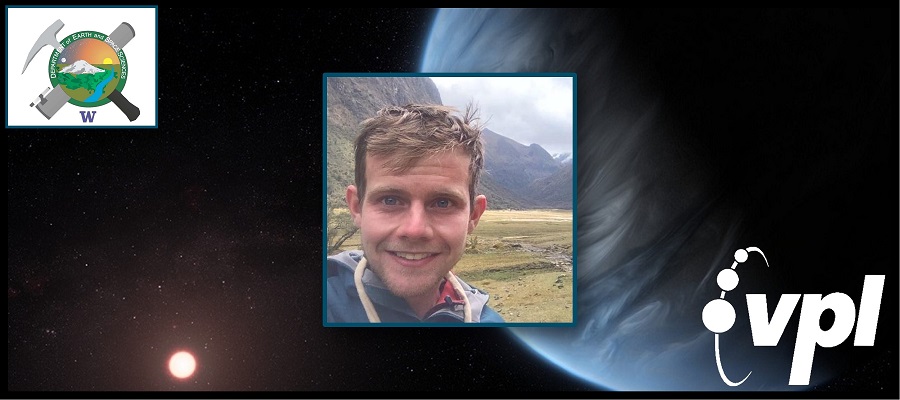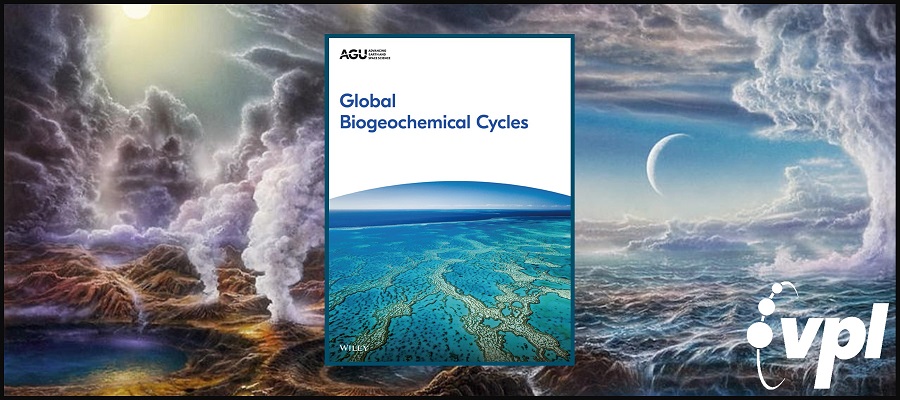VPL graduate student Nick Wogan (University of Washington), researcher and former student Dr. Josh Krissansen-Totton (University of California, Santa Cruz)…
Earth’s carbon cycle maintains a stable climate and biosphere on geological timescales. Feedbacks regulate the size of the surface carbon reservoir, and on million‐year timescales the carbon cycle must be in steady state. A major question about the early Earth is whether carbon was cycled through the surface reservoir more quickly or slowly than it is today. The answer to this question holds important implications for Earth’s climate state, the size of the biosphere through time, and the expression of atmospheric biosignatures on Earth‐like planets. Here, we examine total carbon inputs and outputs from the Earth’s surface over time. We find stark disagreement between the canonical histories of carbon outgassing and carbon burial, with the former implying higher rates of throughput on the early Earth and the latter suggesting sluggish carbon cycling. We consider solutions to this apparent paradox and conclude that the most likely resolution is that high organic burial efficiency in the Precambrian enabled substantial carbon burial despite limited biological productivity. We then consider this model in terms of Archean redox balance and find that in order to maintain atmospheric anoxia prior to the Great Oxidation Event, high burial efficiency likely needed to be accompanied by greater outgassing of reductants. Similar mechanisms likely govern carbon burial and redox balance on terrestrial exoplanets, suggesting that outgassing rates and the redox state of volcanic gases likely play a critical role in setting the tempo of planetary oxygenation.
Here we investigate whether magmatic volcanic outgassing on terrestrial planets can produce atmospheric CH4 and CO2 with a thermodynamic model. Our model suggests that volcanoes are unlikely to produce CH4 fluxes comparable to biological fluxes. Improbable cases where volcanoes produce biological amounts of CH4 also produce ample carbon monoxide. We show, using a photochemical model, that high abiotic CH4 abundances produced by volcanoes would be accompanied by high CO abundances, which could be a detectable false-positive diagnostic. Overall, when considering known mechanisms for generating abiotic CH4 on terrestrial planets, we conclude that observations of atmospheric CH4 with CO2 are difficult to explain without the presence of biology when the CH4 abundance implies a surface flux comparable to modern Earth’s biological CH4 flux
The balance between carbon outgassing and carbon burial controls Earth’s climate on geological timescales. Carbon removal in carbonates consumes both atmospheric carbon and ocean carbonate alkalinity sourced from silicate weathering on the land or seafloor. Reverse weathering (RW) refers to clay-forming reactions that consume alkalinity but not carbon. If the cations (of alkalinity) end up in clay minerals rather than in the carbonates, carbon remains as atmospheric , warming the climate. Higher silicate weathering fluxes and warmer temperatures are then required to balance the carbon cycle. It has been proposed that high dissolved silica concentrations resulting from the absence of ecologically significant biogenic silica precipitation in the Precambrian drove larger RW fluxes than today, affecting the climate. Here, we present the first fully coupled carbon-silica cycle model for post-Hadean Earth history that models climate evolution self-consistently (available as open source code). RW fluxes and biogenic silica deposition fluxes are represented using a sediment diagenesis model that can reproduce modern conditions. We show that a broad range of climate evolutions are possible but most plausible scenarios produce Proterozoic warming (+5 K relative to without RW), which could help explain the sustained warmth of the Proterozoic despite lower insolation. RW in the Archean is potentially more muted due to a lower land fraction and sedimentation rate. Key model uncertainties are the modern reverse weathering flux, the rate coefficient for RW reactions, and the solubility of authigenic clays. Consequently, within the large uncertainties, other self-consistent scenarios where Proterozoic RW was unimportant cannot be excluded. Progress requires better constraints on parameters governing RW reaction rates including explicit consideration of cation-limitations to Precambrian RW, and perhaps new inferences from Si or Li isotopes systems.
Constraining the surface environment of the early Earth is essential for understanding the origin and evolution of life. The release of cations from silicate weathering depends on climatic temperature and urn:x-wiley:ggge:media:ggge22102:ggge22102-math-0001, and such cations sequester urn:x-wiley:ggge:media:ggge22102:ggge22102-math-0002 into carbonate minerals in or on the seafloor, providing a stabilizing feedback on climate. Previous studies have suggested that this carbonate?silicate cycle can keep the early Earth’s surface temperature moderate by increasing urn:x-wiley:ggge:media:ggge22102:ggge22102-math-0003 to compensate for the faint young Sun. However, the Hadean Earth experienced a high meteorite impactor flux, which produced ejecta that is easily weathered by carbonic acid. In this study, we estimated the histories of surface temperature and ocean pH during the Hadean and early Archean using a new model that includes the weathering of impact ejecta, empirically justified seafloor weathering, and ocean carbonate chemistry. We find that relatively low urn:x-wiley:ggge:media:ggge22102:ggge22102-math-0004 and surface temperatures are probable during the Hadean, for example, at 4.3 Ga, urn:x-wiley:ggge:media:ggge22102:ggge22102-math-0005 (in bar) is urn:x-wiley:ggge:media:ggge22102:ggge22102-math-0006 urn:x-wiley:ggge:media:ggge22102:ggge22102-math-0007 and temperature is urn:x-wiley:ggge:media:ggge22102:ggge22102-math-0008 urn:x-wiley:ggge:media:ggge22102:ggge22102-math-0009 K. Such a low urn:x-wiley:ggge:media:ggge22102:ggge22102-math-0010 would result in a circumneutral to basic pH of seawater, for example, urn:x-wiley:ggge:media:ggge22102:ggge22102-math-0011 urn:x-wiley:ggge:media:ggge22102:ggge22102-math-0012 at 4.3 Ga. A probably cold and alkaline marine environment is associated with a high impact flux. Hence, if there was an interval of an enhanced impact flux, that is, Late Heavy Bombardment, similar conditions may have existed in the early Archean. Therefore, if the origin of life occurred in the Hadean, life likely emerged in a cold global environment and probably spread into an alkaline ocean.
“A group of leading researchers in astronomy, biology and geology have come together under NASA’s Nexus for Exoplanet System Science, or…
(Astrobiology, 2016)
Organic and inorganic carbon isotope records reflect the burial of organic carbon over geological timescales. Permanent burial of organic carbon in the crust or mantle oxidizes the surface environment (atmosphere, ocean and biosphere) by removing reduced carbon. It has been claimed that both organic and inorganic carbon isotope ratios have remained approximately constant throughout Earth’s history, thereby implying that the flux of organic carbon burial relative to the total carbon input has remained fixed and cannot be invoked to explain the rise of atmospheric oxygen (Schidlowski, 1988; Catling and others, 2001; Holland, 2002; Holland, 2009; Kump and others, 2009; Rothman, 2015). However, the opposite conclusion has been drawn from the same carbon isotope record (Des Marais and others, 1992; Bjerrum and Canfield, 2004). To test these opposing claims, we compiled an updated carbon isotope database and applied both parametric and non-parametric statistical models to the data to quantify trends and mean-level changes in fractional organic carbon burial with associated uncertainties and confidence levels.


